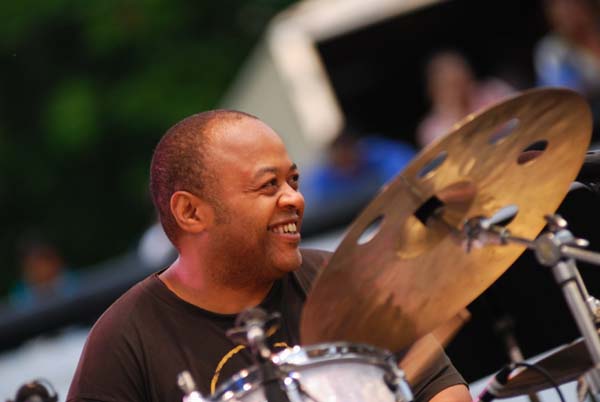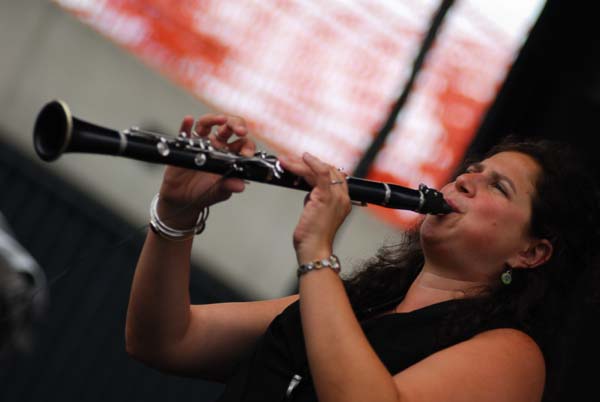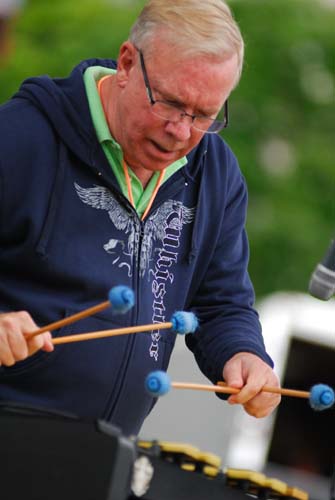Home » Jazz Articles » Live Review » Detroit Jazz Festival: Detroit, MI September 2-5, 2011
Detroit Jazz Festival: Detroit, MI September 2-5, 2011

Detroit, MI
September 2-5, 2011
As chance would have it, over the past 20 years or so attending the Labor Day festivities at the Detroit Jazz Festival, there have only been a handful of weekends marked by less than optimum weather conditions. On average, the gods have largely smiled down upon the plethora of jazz devotees gathered at Hart Plaza on the banks of Lake Michigan. And when you start to think about it, you realize those are some pretty good odds; ones any betting man would take to the bank.
This year's 32nd annual edition of the festival would, however, be marked by extreme weather conditions that certainly tried even the most hard-boiled of jazz enthusiasts. In fact, by the time Friday night's activities got in full swing about 6:30 pm, the temperature in the shade was well over 90 degrees, forcing a decision to opt out of making the trek to Campus Martius for a duo of opening sets, instead preferring to get a bite to eat, followed by a return to the air conditioned comfort of the hotel. The rest of the weekend held its own share of weather ups and downs, including plenty of rain and cooler temperatures that came in by Labor Day Monday.
Another scorcher of a day, Saturday brought with it humid conditions that meant one could work up a sweat just clapping between numbers. Nonetheless, an eclectic mix of music made for some great listening, even if it also meant hopping back and forth between various stages. As the sun beat down on the grassy area directly in front of the Waterfront Stage, people scrambled to find some shade as vibraphonist Warren Wolf debuted his group WOLFPAC, making it made clear that a new star was on the rise.
 Performing several originals from his newly released, self-titled Mack Avenue debut, Wolf struck a chord with his smart arrangements and spirited melodies that he often voiced, together with alto saxophonist Tim Green. "Sweet Bread" and "427 Mass Ave." most succinctly addressed Wolf's virtues, as they managed to find new routes to explore familiar ground within the mainstream tradition. And even on an instrument that can sound somewhat impersonal in lesser hands, Wolf managed to speak with authority and a true identity. Likewise could be said for pianist Lawrence Fields—who got a further chance to shine later in the fest, as a member of drummer Jeff Tain Watts' quartet—and drummer John Lamkin.
Performing several originals from his newly released, self-titled Mack Avenue debut, Wolf struck a chord with his smart arrangements and spirited melodies that he often voiced, together with alto saxophonist Tim Green. "Sweet Bread" and "427 Mass Ave." most succinctly addressed Wolf's virtues, as they managed to find new routes to explore familiar ground within the mainstream tradition. And even on an instrument that can sound somewhat impersonal in lesser hands, Wolf managed to speak with authority and a true identity. Likewise could be said for pianist Lawrence Fields—who got a further chance to shine later in the fest, as a member of drummer Jeff Tain Watts' quartet—and drummer John Lamkin.Coming on with a mature sense of poise and a tropical ebullience that matched the climate, singer Luciana Souza delivered a set at the Pyramid Stage, with guitarist Romero Lubambo, that begged the question as to why she has not become more prominent on the current scene. Unlike some of her contemporaries, Souza never comes off as coy or cute. Her intonation is superb and her versatility is an obvious asset. Adding a bit of weight to these delicate duets, Souza peppered the music with her own percussion flourishes, playing brushes on a flat surface and adding some shakers and pandeiro. The duo's Jobim interpretations were spot on and it was obvious that both Souza and Lubambo were having one hell of a good time.
Come mid-afternoon, the decisions became harder in terms of choosing which stage to gravitate towards. Beginning with Detroit native Curtis Fuller's set at the Waterfront, I soon found my attention wandering. While pianist Mike LeDonne and tenor man Eric Alexander kept the pots on, drummer Carl Allen seemed to be too polite at times, and Fuller seemed a bit disconnected from the proceedings.
More engaging was an accomplished set by trumpeter Sean Jones and his group over at the Amphitheatre Stage. Even as many times as Jones has made an appearance at the festival over the past several years, he never fails to speak with a renewed sense of purpose and his original compositions are the fodder that makes it all happen. Pianist Orrin Evans was the man about town in his various appearances during the weekend, including this set with Jones. His solo on "Olive Juice" was a rare combination of chops and advanced storytelling, further support for the claim that he remains one the most original voices on the current scene.

Sean Jones
Back to the Waterfront, another duo was poised to make an impression. Soon to celebrate his 90th year, harmonica virtuoso Toots Thielemans shared the stage with pianist Kenny Werner, and the two managed some sublime moments that provided relief from the obsessive heat that lingered prior to an approaching storm.
By 7:00 pm, the skies opened and rain poured down as crowds scattered to take cover. The tarps came out as crews scrambled to cover up instruments and unplug microphones. Soon, the power went out to all the stages and the scuttlebutt that started to spread was that things might be closing down for the evening. Over at the Amphitheatre, the Sun Ra Arkestra barely got started before high winds forced an end to their set. After the recent tragedy at the Indiana State Fair, I'm sure a heightened sense of caution came with the final decision to close up shop, as further storm fronts threatened to move through the area for the rest of the night.
 Jeff "Tain" Watts
Jeff "Tain" WattsSeveral national headliners had been slated to conclude Saturday's evening's festivities, with fireworks to follow closely thereafter. Sets from Deacon Jones Blues Revue, Mandrill, organist Tony Monaco, Jason Moran, and the Dave Holland were hanging in the balance as artistic director Terri Pontremoli and her staff pondered the alternatives. Soon came word that things would move to the bar at the Marrriot Renaissance, the host hotel for the festival. It was reported that Moran was asked to start things off followed by Holland, but the pianist declined.
Around 9:30 pm, Holland and his ensemble decided to make the best of the situation and proceeded to mesmerize a standing room-only crowd that hung on the band's every move. One could say the air was electric both inside and out, as the band hit its incendiary stride and lightning lit up the night sky. Holland favorites like "Blue Jean" and "Happy Jammy" provided fodder for Gary Smulyan's blustery baritone and Chris Potter razor sharp tenor. Those wanting to rub shoulders with some of the festival's stars had no problem spotting fellow onlookers like Joe Lovano, Christian McBride, and Joe Locke. After the set, Smulyan said that the band hadn't played a gig in about a year, and so they were ready to bring it. Knowing the intricacies of the octet's charts made the magic of the evening seem even more miraculous. Joining us in conversation, alto saxophonist Steve Wilson said that Holland's set was one of the best things he has ever seen, a sentiment shared by just about everybody in the room.
Following Saturday's storms, the temperatures retreated to more comfortable levels. Starting Sunday afternoon listening to two big band sets at the Amphitheatre Stage, The US Airmen of Note featured special guest vibraphonist Joe Locke, while bassist Rodney Whitaker directed the Michigan State University Jazz Orchestra, with artist-in-residence Jeff Tain Watts. The former of the two sets proved to be the most cohesive, with Locke playing an integral part in the arrangements, and bringing inspired charts with him on such iconic numbers as John Coltrane's "Naima," Wayne Shorter's "Gaucho," and Chick Corea's "Inner Space."
Later that day, Anat Cohen delivered a fantastic set, with a singular voice on clarinet and soprano saxophone that set her apart from her peers. Also impressive was Cohen's versatility and ability to speak in a variety of genres, from the Brazilian strains of a rare Milton Nascimento number to the authentic son montuno of "Siboney." There every step of the way, and adding his own incendiary accoutrements, was pianist Jason Lindner, who has gone underappreciated for far too long. His prepared piano on "All Brothers" gave the piece its appropriate "world music" vibe, while his stride chops were put on display for "Jay Blues."

Anat Cohen
The rest of the evening proved to be a challenge and provided the only caveat for what was an otherwise superb festival. An embarrassment of riches made for overlapping performances, and the only remedy was to try to catch a few numbers in piecemeal fashion on one stage, before hopping over to another—hanging around the Amphitheatre to check out Jeff Tain Watts, for example, and then returning later in the evening for the first number from Joe Lovano and Us Five.
In between, the decision to keep feet firmly planted at the Pyramid for Steve Wilson and Wilsonian Grain was duly rewarded. Another sagacious choice for the fest, Wilson has become a yeoman of sorts who has appeared on hundreds of recordings, but has also quietly been doing his own thing for many years now. The alto saxophonist paced a perfect set with a little bit of something for everyone, from a Thelonious Monk tune to his own "Step Lively," a musical account of a New York City subway ride. Pianist Orrin Evans was typically inspired, as was Clarence Penn, an animated drummer who upped the ante with his incredibly musical style.
Opting for a change of pace to wrap up the evening, by taking a long walk over to the Main Stage at Campus Martius, technical difficulties meant a lengthy delay in the start of Brazilian icon Ivan Lins' show. Patience started to wane as the eleven o'clock start time for the rescheduled fireworks loomed closer. While Lins' voice seemed to waver at times, and his keyboard skills were not on par with the rest of the musicians in his quartet, the overall results were nonetheless significant. Lins managed to squeeze in several of his crowd pleasers, including "Comecar de Novo" and "Velas." Still, it would prove to be an abbreviated set.
 One step outside on Labor Day morning, and you could feel that the chill of autumn was likely just around the corner. Surely attendance numbers would reflect a smaller crowd this year and yet no one should take the blame on that one, considering the profusion of dramatic weather. Just a few blocks away, President Obama was set to speak before a substantial throng, and that surely accounted for the modest few gathered at the Amphitheatre for a 1:30 pm set by The New Gary Burton Quartet, although the house was full by the end of the show.
One step outside on Labor Day morning, and you could feel that the chill of autumn was likely just around the corner. Surely attendance numbers would reflect a smaller crowd this year and yet no one should take the blame on that one, considering the profusion of dramatic weather. Just a few blocks away, President Obama was set to speak before a substantial throng, and that surely accounted for the modest few gathered at the Amphitheatre for a 1:30 pm set by The New Gary Burton Quartet, although the house was full by the end of the show.Easily one of the best performances of the festival, Burton reinvented himself with a musical outlook that was in step with the current generation. Mixing in standards and tunes written by his new band mates, Burton's genius came through, not only in his own solos, but also in the chemistry that took place between guitarist Julian Lage, bassist Scott Colley, and drummer Antonio Sanchez.
Lage was certainly the ringer here, and his comparisons to Pat Metheny were understandable. He even sported a guitar made by Linda Manzer, a luthier who also happens to have worked with Metheny for many years. But make no mistake, Lage is his own man and his kaleidoscopic sound took in a little bit of everything, a fact gleaned from a marvelous solo feature that morphed from free form into a gentle "My Funny Valentine."
Another obvious Metheny connection comes via Sanchez, who has been employed by the guitarist for many years now. His own muse is marked by a mature sense of composition. Both "Common Ground" and "Did You Get It?" provided ample structures for improvisation, including his own technically brilliant drum solos. Burton and company afforded a superb conclusion for a weekend smorgasbord of music. So, while several more performers waited in the wings, the long trip back home was calling my name. Despite the elements, the show did indeed go on. In fact, it did so with a vengeance, and the sheer volume of music that always accompanies this festival marks it as one of the best in the world, and certainly a treasure as the reigning largest free jazz festival in North America.
Photo Credit
All Photos: C. Andrew Hovan
< Previous
Take Five With Laura Ainsworth
Next >
The Good Feeling
Comments
Tags
detroit jazz festival
Live Reviews
C. Andrew Hovan
United States
Warren Wolf
Tim Green
Jeff "Tain" Watts
John Lamkin
Luciana Souza
Romero Lubambo
Curtis Fuller
Mike LeDonne
Eric Alexander
Carl Allen
Sean Jones
Orrin Evans
Toots Thielemans
Kenny Werner
Sun Ra Arkestra
Deacon Jones Blues Revue
tony monaco
Jason Moran and Bandwagon
Dave Holland Octet
Gary Smulyan
Chris Potter
joe lovano
Christian McBride
Joe Locke
Steve Wilson
The US Airmen of Note
Rodney Whitaker
John Coltrane
Wayne Shorter
Chick Corea
Anat Cohen
Milton Nascimento
Jason Lindner
Thelonious Monk
Clarence Penn
Ivan Lins
Gary Burton
Julian Lage
Scott Colley
Antonio Sanchez
pat metheny
For the Love of Jazz
 All About Jazz has been a pillar of jazz since 1995, championing it as an art form and, more importantly, supporting the musicians who create it. Our enduring commitment has made "AAJ" one of the most culturally important websites of its kind, read by hundreds of thousands of fans, musicians and industry figures every month.
All About Jazz has been a pillar of jazz since 1995, championing it as an art form and, more importantly, supporting the musicians who create it. Our enduring commitment has made "AAJ" one of the most culturally important websites of its kind, read by hundreds of thousands of fans, musicians and industry figures every month.






















